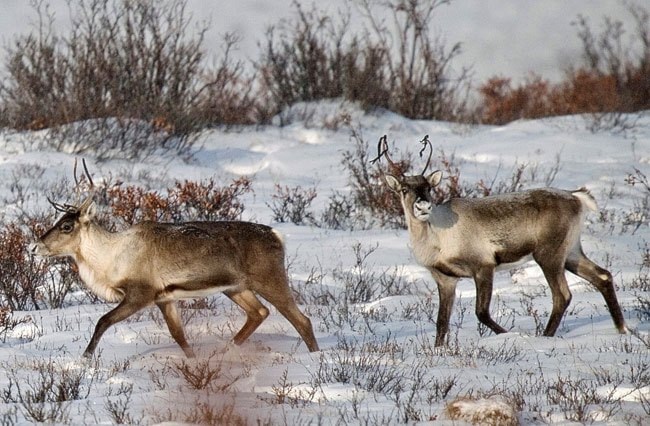The Porcupine caribou herd has grown to 169,000 animals, according to aerial photocensus results released Wednesday.
The count offered a welcome surprise to wildlife managers, who spent the past nine years issuing gloomy warnings the herd has likely continued to dwindle in size since the completion of the last successful photocensus in 2001, when the herd numbered 123,000 - a big drop from 1989, when the herd’s population peaked at 178,000.
“We were surprised. We weren’t expecting it to be that high,” said Jason Caikoski, a biologist with Alaska’s Department of Fish and Game.
“But it’s not unreasonable or unexplainable. It’s a two to four per cent annual growth rate, which is basically nothing for a caribou herd. We’ve seen growth rates double that in other herds.
“The bottom line is, just a couple percent change in adult survival, and those herds can really grow.”
In a controversial move, the Yukon government banned hunting the herd’s cows in the autumn of 2009. At the time, the herd’s size was estimated at between 90,000 and 100,000 animals - precariously close to a tipping point biologists believed would cause the herd size to further plummet, if hunting continued unchecked.
The ban provoked an uproar among some First Nation and Inuvialiut hunters, who felt their constitutionally protected right to hunt were being trammelled. With the herd’s size revised upwards by nearly 50,000 animals, the territory is now reviewing its regulations.
“It vindicates what our elders have been saying,” said Eddie Taylor, chief of the Tr’ondek Hwech’in.
The Porcupine herd may travel over 1,000 kilometres during its annual migrations. It winters in the Yukon’s Richardson and Ogilvie mountain ranges, then, in the spring, begins a two-month trek towards Alaska’s Arctic National Wildlife Refuge to calf. En route they cross the Dempster Highway, where many hunters from the Northwest Territories and the Yukon gather to hunt.
The Porcupine Caribou Management Board will soon release its recommended hunting rules for the coming year. Joe Tetlichi, the board’s chair, said he wasn’t concerned that conservation efforts would lose their sense of urgency now that the herd’s numbers are known to be high.
“We never want to see the plan gather dust,” he said. “It’s a plan for all times.”
Verifying the herd’s size proved fiendishly difficult. An aerial photocensus is accomplished by capturing the entire herd on film, using a large-format camera mounted to the bottom of a Beaver bush plane.
For this to work, several important ingredients must be in place: the herd must be bunched together, as it often is in the late summer as a defense against ravenous bugs, and the weather must be clear enough for the caribou to be clearly identifiable.
For the previous nine seasons these efforts have been hampered, either by foggy weather, or by the herd dispersing earlier than usual into the mountains, where it’s often difficult to distinguish caribou, seen as little more than specks on film, from craggy rocks and shadows.
Last summer, the right conditions arose. It was a bright, sunny day, and the caribou were tightly packed together.
Then Caikoski and others had the tedious task of stitching together roughly 450 photographs and hand-counting each caribou using a magnifying glass. It took several months.
Caikoski reckons three-quarters of the photographs were “good to excellent,” while the remaining quarter were “fair to good.”
“Overall, it was a very high-quality photocensus.”
The photocensus captured every animal with a radio collar, which suggests that they didn’t miss many.
Alaska has considered alternatives to a photocensus. Other herds are tracked by biologists in Canada by flying in a grid pattern over the herd and then using statistics to fill in the blanks. But these studies are costly, and the results would be far less robust than a photocensus, said Caikoski.
“The uncertainty in the estimate is so large, it would be difficult to say what the herd has done, unless you can get a bunch of those done in a row, back to back.”
Biologists have also studied the survival rate of calves in the herd, among other factors. With no apparent changes since the herd’s drop started, “we took the conservative approach that the herd may still be declining,” said Caikoski.
“There’s going to be a lot of people shocked at the number. ‘How could it be this big?’ I just want people to understand it’s been years, and with a very small change in adult cow survival, maybe increased a couple of percent, we could easily have this many caribou.
“The problem is, detecting that change is very hard for biologists. So I think both Alaska and Yukon took the prudent approach, which was a conservative one, assuming that the herd was either similar to the last photocensus in size or continued to decline.”
Contact John Thompson at
johnt@yukon-news.com.
